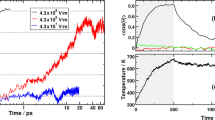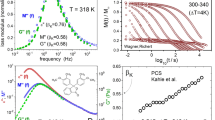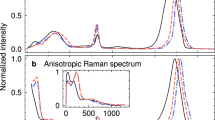Abstract
LIQUID water has a strong far-infrared polarisation. The origin of this has rarely been discussed in detail, although it causes the difference between the optical permittivity of about 1.8, and the limiting high frequency microwave (ɛ∞) permittivity of about 4.2. The phenomenon has been attributed by Zafar et al.1 to a high frequency relaxation of amplitude 2.4 in the permittivity, and a relaxation time of ∼ 50 ns resulting from the orientation of water molecules that are free of hydrogen bonds. Unfortunately, the authors did not apply Sherlock Holmes'2 adage that when you have eliminated the impossible, whatever remains, however improbable, must be the truth. Not all possible explanations of this polarisation have been considered and eliminated, although the correct one has been mentioned. There can be little doubt that there is, at present, no evidence for a new orientational relaxation.
This is a preview of subscription content, access via your institution
Access options
Subscribe to this journal
Receive 51 print issues and online access
$199.00 per year
only $3.90 per issue
Buy this article
- Purchase on Springer Link
- Instant access to full article PDF
Prices may be subject to local taxes which are calculated during checkout
Similar content being viewed by others
References
Zafar, M. S., Hasted, J. B., and Chamberlain, J., Nat ure phys Sci., 243, 106 (1973).
Doyle, A. C., The Sign of Four.
Bertie, J. E., Labbé, H. J., and Whalley, E., J. chem. Phys., 50, 4501 (1969).
Ikawa, S.-I., and Maeda, S., Spectrochim. Acta, 24 A, 655 (1968).
Whalley, E., and Labbé, H. J., J. chem. Phys., 51, 3120 (1969).
Klug, D. D., and Whalley, E., in Physics and Chemistry of Ice (edit. by Whalley, E., Jones, S. J., and Gold, L. W.), 93 (Royal Society of Canada, Ottawa, 1973).
Bertie, J. E., and Whalley, E., J. chem. Phys., 46, 1271 (1967).
Eisenberg, D., and Kauzmann, W., The structure and properties of water, 205. (Clarendon Press, Oxford, 1969).
Robertson, C. W., Curnutte, B., and Williams, D., Molec. Phys., 26, 183 (1973).
Walrafen, G. E., Water: A comprehensive treatise, vol. 1 (edit. by Franks, F.), chapter 5 (Plenum Press, New York, 1972).
Author information
Authors and Affiliations
Rights and permissions
About this article
Cite this article
WHALLEY, E. The origin of the far-infrared polarisation of liquid water. Nature 251, 217–218 (1974). https://doi.org/10.1038/251217a0
Received:
Revised:
Issue Date:
DOI: https://doi.org/10.1038/251217a0
This article is cited by
-
High-frequency dielectric constant of water and determination of the Kirkwood correlation factor
Journal of Structural Chemistry (1987)
-
The origin of the far-infrared polarisation of liquid water (Reply)
Nature (1974)
Comments
By submitting a comment you agree to abide by our Terms and Community Guidelines. If you find something abusive or that does not comply with our terms or guidelines please flag it as inappropriate.



